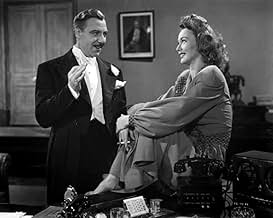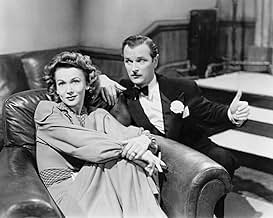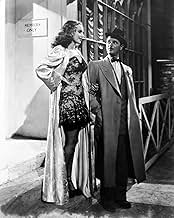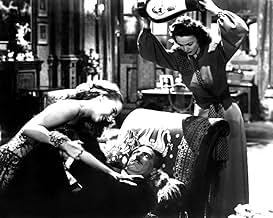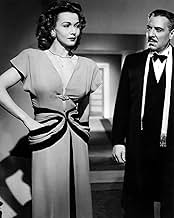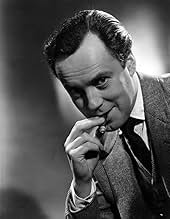Agrega una trama en tu idiomaIn post- WW2 Britain, an American fashion journalist, her ex-army fiancé, and a gang of honest toughs from a local gym attempt to bring black market organized crime to justice.In post- WW2 Britain, an American fashion journalist, her ex-army fiancé, and a gang of honest toughs from a local gym attempt to bring black market organized crime to justice.In post- WW2 Britain, an American fashion journalist, her ex-army fiancé, and a gang of honest toughs from a local gym attempt to bring black market organized crime to justice.
Carol van Derman
- Mercia Lane
- (as Carol Van Derman)
Opiniones destacadas
Edmond Greville brought a gallic sensibility to this vivid evocation of the postwar days when Soho was a byword for criminality and vice, fluidly photographed by Hone Glendinning and ending in a slam-bang finale.
Obligatory American imports Joseph Calleia and Carole Landis both give excellent accounts of themselves as "the nastiest thug in Europe" and his nemesis "the best fashion editor in the business". A uniformly memorable supporting cast include Nigel Patrick in full-on spiv mode, John Salew as Patrick's perspiring courier rejoicing in the name 'Greasy', and Hay Petrie in his creepiest role since he played Quilp as a murderous henchman known only as 'The Barber'.
Obligatory American imports Joseph Calleia and Carole Landis both give excellent accounts of themselves as "the nastiest thug in Europe" and his nemesis "the best fashion editor in the business". A uniformly memorable supporting cast include Nigel Patrick in full-on spiv mode, John Salew as Patrick's perspiring courier rejoicing in the name 'Greasy', and Hay Petrie in his creepiest role since he played Quilp as a murderous henchman known only as 'The Barber'.
NOOSE is a well-plotted but oddly uninspiring little crime film which deals with efforts to bring down an Italian black market racketeer operating in London following WW2. His sheer breadth of power means that the authorities are powerless against him, until a lone female reporter decides to write a scoop that brings him out of the woodwork and up against her.
There's some great material in the narrative here, including a completely amoral villain who enjoys using knuckle dusters to beat up women! The stark gang violence makes ahead of its time, but it's a pity that the execution is less than stellar. The film plods when it should grip, and it only really gets going in the last twenty minutes or so, with an unusual and rather powerful climax. It's one of those rare films where the women are both empowered and sexualised, leaving the men looking weak by comparison.
The tragic Carole Landis stars in her penultimate acting role before her untimely suicide and very good she is too: bright, brassy, and running rings around the menfolk. Joseph Calleia and Derek Farr are rather uninspired as the rival protagonists, though we do get the likes of Stanley Holloway in support, and even a brief cameo for Michael Ripper. Nigel Patrick is something of a scene stealer as a loud-mouth spiv, and although his telephone manner is absolutely hilarious, I found his brash character ended up being too over the top for his own good.
There's some great material in the narrative here, including a completely amoral villain who enjoys using knuckle dusters to beat up women! The stark gang violence makes ahead of its time, but it's a pity that the execution is less than stellar. The film plods when it should grip, and it only really gets going in the last twenty minutes or so, with an unusual and rather powerful climax. It's one of those rare films where the women are both empowered and sexualised, leaving the men looking weak by comparison.
The tragic Carole Landis stars in her penultimate acting role before her untimely suicide and very good she is too: bright, brassy, and running rings around the menfolk. Joseph Calleia and Derek Farr are rather uninspired as the rival protagonists, though we do get the likes of Stanley Holloway in support, and even a brief cameo for Michael Ripper. Nigel Patrick is something of a scene stealer as a loud-mouth spiv, and although his telephone manner is absolutely hilarious, I found his brash character ended up being too over the top for his own good.
Note: this is a review for the full-length UK version of this film entitled NOOSE.
It is always a pleasure to see a film noir that is not only entertaining, artistically satisfying and a little off-beat, but one that is little heard of. NOOSE, a British film from 1948, has many of the visual and plot elements of the American crime dramas made in the forties, and this one even features, unexpectedly, two American stars, Carole Landis and Joseph Calleia. Landis is a fashion reporter who, after getting a story from a girl who is later murdered, wants to get the goods on the man responsible for her death, a notorious and powerful black marketeer, even when she learns that it will entail personal danger to her. She is supported by her newly demobbed fiancé, who enlists a gang of toughs from the local gym to try to bring down the racketeer's empire. Quite a ride from here. --- The story was based on a play by Richard Llewellyn (noted for HOW GREEN WAS MY VALLEY), but it betrays little of its non-cinematic origins. Director Edmond Greville (a French-English director who began his career working with Abel Gance and ended it with the sleaze classic BEAT GIRL) lends the film considerable artistic flare -- the staging and camera angles will often surprise you; so much so that you sometimes believe you are watching an auteur film. Music is by the great Charles Williams (Dream of Olwen, Theme from the APARTMENT) and adds to the film. The cast is a standout, even though it occasionally seems to work to cross purposes. Carole Landis, who made her last two films in England, was not only an actress, but a singer, USO trouper, and baseball fan (her name came from Commissioner Kennesaw Mountain Landis!). Her career was lamentable spotty and her personal life a disaster, but she was a delight and it is a pity that shortly after this film she supposedly committed suicide (or, as some believe, was done in or something by her married boyfriend Rex Harrison.) Here she is vivacious and gives a performance well beyond that of the usual wise-cracking girl reporter. Derek Farr, always competent, seems bland by comparison and their pairing seems odd -- but the War did produce some odd couples. Joseph Calleia, originally Maltese, was a fixture in Hollywood during the forties and early fifties playing villains in gangster pictures and Westerns. As the kingpin black marketeer of foreign extraction he is simply superb, a performance Edward G. could not have bettered. Rivaling him for film time and stealing all his scenes, though, is Nigel Patrick as the flamboyant Cockney spiv who works for him. Stanley Holloway, known for comedic parts (LAVENDER HILL MOB, MY FAIR LADY) has an unusual dramatic turn as a policeman. --- This film is intriguing and eminently worth seeing, probably more than once, although, on the negative side, it is marred by an unevenness in tone, inconsistent pacing, and editing that disrupts the smooth telling of the story. -- also a few loose ends, such as what was the significance of Carole's character constantly taking her shoes off? Nevertheless, highly recommended for film noir fans!
It is always a pleasure to see a film noir that is not only entertaining, artistically satisfying and a little off-beat, but one that is little heard of. NOOSE, a British film from 1948, has many of the visual and plot elements of the American crime dramas made in the forties, and this one even features, unexpectedly, two American stars, Carole Landis and Joseph Calleia. Landis is a fashion reporter who, after getting a story from a girl who is later murdered, wants to get the goods on the man responsible for her death, a notorious and powerful black marketeer, even when she learns that it will entail personal danger to her. She is supported by her newly demobbed fiancé, who enlists a gang of toughs from the local gym to try to bring down the racketeer's empire. Quite a ride from here. --- The story was based on a play by Richard Llewellyn (noted for HOW GREEN WAS MY VALLEY), but it betrays little of its non-cinematic origins. Director Edmond Greville (a French-English director who began his career working with Abel Gance and ended it with the sleaze classic BEAT GIRL) lends the film considerable artistic flare -- the staging and camera angles will often surprise you; so much so that you sometimes believe you are watching an auteur film. Music is by the great Charles Williams (Dream of Olwen, Theme from the APARTMENT) and adds to the film. The cast is a standout, even though it occasionally seems to work to cross purposes. Carole Landis, who made her last two films in England, was not only an actress, but a singer, USO trouper, and baseball fan (her name came from Commissioner Kennesaw Mountain Landis!). Her career was lamentable spotty and her personal life a disaster, but she was a delight and it is a pity that shortly after this film she supposedly committed suicide (or, as some believe, was done in or something by her married boyfriend Rex Harrison.) Here she is vivacious and gives a performance well beyond that of the usual wise-cracking girl reporter. Derek Farr, always competent, seems bland by comparison and their pairing seems odd -- but the War did produce some odd couples. Joseph Calleia, originally Maltese, was a fixture in Hollywood during the forties and early fifties playing villains in gangster pictures and Westerns. As the kingpin black marketeer of foreign extraction he is simply superb, a performance Edward G. could not have bettered. Rivaling him for film time and stealing all his scenes, though, is Nigel Patrick as the flamboyant Cockney spiv who works for him. Stanley Holloway, known for comedic parts (LAVENDER HILL MOB, MY FAIR LADY) has an unusual dramatic turn as a policeman. --- This film is intriguing and eminently worth seeing, probably more than once, although, on the negative side, it is marred by an unevenness in tone, inconsistent pacing, and editing that disrupts the smooth telling of the story. -- also a few loose ends, such as what was the significance of Carole's character constantly taking her shoes off? Nevertheless, highly recommended for film noir fans!
Tangy post-War British 'Spiv' movie (a cycle of films with roots in 30s American Gangster movies, featuring characters profiting from wartime rationing in a similar fashion to 30s bootleggers, but not so clearly glamorised as their Stateside equivalents). Directed by Edmond T. Greville (BEAT GIRL aka WILD FOR KICKS), and adapted from a stage play, this features Carole Landis (in one of her final roles) as nosy reporter Linda Medbury who, together with her ex-commando boyfriend Jumbo Hoyle (played by Derek Farr), gets on the trail of a gang of post-war black marketeers headed by Soho nightclub owner Sugiani, played by Joseph Calleia (whose role was based on a real-life Post-war London criminal). This gets them mixed up with London 'Spiv' Bar Gorman, played by Nigel Patrick, whose slangy, comic performance almost overshadows the surrounding film. Imaginatively shot, speedily paced, and ripe with post-War vernacular and the requisite criminal dust-ups (primarily involving the good guys' recruited gang of boxers, market porters, and cab drivers versus the low-life criminals), this is an entertaining slice of British crime and deserves to be better known, as it's worthy of a place alongside such noted post-War British crime movies as BRIGHTON ROCK and NIGHT AND THE CITY. Check it out, if you get the chance.
Although visiting American actress Carole Landis gets top billing in the 1948 British crime thriller, "The Silk Noose" (AKA "The Noose"), it's the much underrated English actor, Nigel Patrick ("The League of Gentlemen," "The Sound Barrier," "Raintree County") who steals this movie.
From his very first appearance yelping cheerful insults into a telephone, Nigel Patrick takes command of this unusual British crime feature, as a flip and glib Cockney gangster who is part conniving Phil Silvers (think "Sgt. Bilko"), part sleazy Michael Palin (think suavely snide East End hoodlum Luigi Vercotti in "Monty Python"), and part fast-talking James Cagney (think "One, Two, Three") .
So wacky and so unexpected and so hilarious is Patrick's maniacal insincerity that you may drum your fingers impatiently during the few scenes that he's not on camera being cheerfully devious -- however action-packed some of those scenes may be. (There is considerable action in "The Silk Noose," some of it nail-biting -- this, after all, is a near-noir crime story with an alarming body count -- but on the whole it's comic-book roughhousing, best captioned by "Pow!" " Bam!" and "Oomph!")
Written by Richard Llewellyn ("How Green Was My Valley," "None But the Lonely Heart"), "The Silk Noose" homes in on "spivs," British racketeers of the late 1940s , grown fat on wartime black market profits, and now still doing their bit for Britain by blithely counterfeiting, smuggling, and, for all we know, loitering and littering. (It may take you back to Jules Dassin's more earnest, better-known "Night and the City," with Richard Widmark, which came along two years later.)
In this particular case, the local don, Sugiani (Joseph Calleia), prefers to perform his perfidy out of a posh Soho nightclub that features très chic chanteuses and très cher champagne. Looking like a Satanic Cesar Romero, Maltese-American actor Joseph Calleia cheerfully overacts, shaking his part until it cries "Basta!" Both sinister and jovial at the same time, Calleia's gangster could be seen as a stand-in for Mussolini – posturing, threatening and begging for adoration simultaneously.
Make no mistake, for all his charm and over-the-top grand opera posturing, Sugiani can be a very dangerous man, particularly when issuing orders to his very own Heinrich Himmler, a spine-chilling personal assassin known as "Barber" (the great Dickensian character actor, Hay Petrie), an unctuous, leering Claude Rains-clone who scuttles around a bleak London like a human cockroach, using a silk stocking ("the noose") as his preferred means of dispatch.
Nigel Patrick's Bar Gorman is Sugiani's right-hand man and/or partner. He could also be a stand-in for Nazi propaganda minister Joseph Goebbels, particularly when barking orders over his huge desktop intercom or trying to wheedle favorable newspaper publicity. The relationship of the two crooks is complicated, and at times the two suddenly snarl at each other like strange dogs passing on the street, then as quickly make up. It's an insane partnership made in Hell, and the two men, continuously on edge, are a fascinating team, blending affinity, iniquity and irrationality.
Into this hidey-hole of Axis-style moray eels merrily steps the Dior-dressed figure of Carole Landis, an American fashion editor working for a London newspaper (don't ask). Dressed to the nines in every shot, Landis, as a brash and beautiful career girl, puts across a delightful sassiness as she investigates a grisly London murder that isn't getting the attention she feels it deserves.
As expected, the trail leads to the bad, bad Sugiani, but, surrounded by his thuggish hirelings, he's apparently invulnerable. However, in a twist reminiscent of the creepy Peter Lorre classic, "M", the muscle-bound laborers of London's docks and markets are enrolled in a vigilante lynch mob, the lumpenproletariat out to take back their streets, and a rousing if unconvincing version of class warfare breaks out as the forces of Good, wearing football jerseys, battle the forces of Evil, in dinner jackets.
With all this, "The Silk Noose" would still be just another dated British "spiv" movie -- though with a few comedic grace notes -- but for Nigel Patrick's virtuoso performance and these three significant particulars :
1. Stanley Holloway, the beloved Alfred P. Doolittle of "My Fair Lady," plays a very well-dressed Scotland Yard inspector who may be on the take, and does it up well. He has a surprisingly commanding presence as a top cop and uses his authoritative voice to get your attention and hold it.
2. The director was Edmond Gréville, who had apprenticed with the legendary Frenchman Abel Gance ("Napoleon") . Besides pacing the movie with fast rhythmic editing, he offers up a boutique of superimposed images, extreme close-ups, artistic camera angles and surprising staging, so you don't dare blink for missing some exciting shot or experimental exposure. (For instance, he shoots one nightclub scene through the multifaceted glass top of a perfume bottle -- giving it the vertiginous viewpoint of a drunken housefly.) There's also an unexpected degree of eroticism, which marked many of the films of this half-French half-British director.
3. "The Silk Noose" was to be the next-to-the-last movie of the tragic Carole Landis, who had died by the time of the film's release in August 1948. A delightful actress with unrealized potential, she had worn herself out with endless USO tours: she had traveled more than 100,000 miles during the war, had spent more time visiting troops than any other actress, and had even caught a nasty case of malaria. By the time she killed herself at the age of 29, she had been married five times. Under still mysterious circumstances, her body was discovered by her married boyfriend, actor Rex Harrison , who, almost two decades later, was to appear with Stanley Holloway in " My Fair Lady", a triumph for them both.
From his very first appearance yelping cheerful insults into a telephone, Nigel Patrick takes command of this unusual British crime feature, as a flip and glib Cockney gangster who is part conniving Phil Silvers (think "Sgt. Bilko"), part sleazy Michael Palin (think suavely snide East End hoodlum Luigi Vercotti in "Monty Python"), and part fast-talking James Cagney (think "One, Two, Three") .
So wacky and so unexpected and so hilarious is Patrick's maniacal insincerity that you may drum your fingers impatiently during the few scenes that he's not on camera being cheerfully devious -- however action-packed some of those scenes may be. (There is considerable action in "The Silk Noose," some of it nail-biting -- this, after all, is a near-noir crime story with an alarming body count -- but on the whole it's comic-book roughhousing, best captioned by "Pow!" " Bam!" and "Oomph!")
Written by Richard Llewellyn ("How Green Was My Valley," "None But the Lonely Heart"), "The Silk Noose" homes in on "spivs," British racketeers of the late 1940s , grown fat on wartime black market profits, and now still doing their bit for Britain by blithely counterfeiting, smuggling, and, for all we know, loitering and littering. (It may take you back to Jules Dassin's more earnest, better-known "Night and the City," with Richard Widmark, which came along two years later.)
In this particular case, the local don, Sugiani (Joseph Calleia), prefers to perform his perfidy out of a posh Soho nightclub that features très chic chanteuses and très cher champagne. Looking like a Satanic Cesar Romero, Maltese-American actor Joseph Calleia cheerfully overacts, shaking his part until it cries "Basta!" Both sinister and jovial at the same time, Calleia's gangster could be seen as a stand-in for Mussolini – posturing, threatening and begging for adoration simultaneously.
Make no mistake, for all his charm and over-the-top grand opera posturing, Sugiani can be a very dangerous man, particularly when issuing orders to his very own Heinrich Himmler, a spine-chilling personal assassin known as "Barber" (the great Dickensian character actor, Hay Petrie), an unctuous, leering Claude Rains-clone who scuttles around a bleak London like a human cockroach, using a silk stocking ("the noose") as his preferred means of dispatch.
Nigel Patrick's Bar Gorman is Sugiani's right-hand man and/or partner. He could also be a stand-in for Nazi propaganda minister Joseph Goebbels, particularly when barking orders over his huge desktop intercom or trying to wheedle favorable newspaper publicity. The relationship of the two crooks is complicated, and at times the two suddenly snarl at each other like strange dogs passing on the street, then as quickly make up. It's an insane partnership made in Hell, and the two men, continuously on edge, are a fascinating team, blending affinity, iniquity and irrationality.
Into this hidey-hole of Axis-style moray eels merrily steps the Dior-dressed figure of Carole Landis, an American fashion editor working for a London newspaper (don't ask). Dressed to the nines in every shot, Landis, as a brash and beautiful career girl, puts across a delightful sassiness as she investigates a grisly London murder that isn't getting the attention she feels it deserves.
As expected, the trail leads to the bad, bad Sugiani, but, surrounded by his thuggish hirelings, he's apparently invulnerable. However, in a twist reminiscent of the creepy Peter Lorre classic, "M", the muscle-bound laborers of London's docks and markets are enrolled in a vigilante lynch mob, the lumpenproletariat out to take back their streets, and a rousing if unconvincing version of class warfare breaks out as the forces of Good, wearing football jerseys, battle the forces of Evil, in dinner jackets.
With all this, "The Silk Noose" would still be just another dated British "spiv" movie -- though with a few comedic grace notes -- but for Nigel Patrick's virtuoso performance and these three significant particulars :
1. Stanley Holloway, the beloved Alfred P. Doolittle of "My Fair Lady," plays a very well-dressed Scotland Yard inspector who may be on the take, and does it up well. He has a surprisingly commanding presence as a top cop and uses his authoritative voice to get your attention and hold it.
2. The director was Edmond Gréville, who had apprenticed with the legendary Frenchman Abel Gance ("Napoleon") . Besides pacing the movie with fast rhythmic editing, he offers up a boutique of superimposed images, extreme close-ups, artistic camera angles and surprising staging, so you don't dare blink for missing some exciting shot or experimental exposure. (For instance, he shoots one nightclub scene through the multifaceted glass top of a perfume bottle -- giving it the vertiginous viewpoint of a drunken housefly.) There's also an unexpected degree of eroticism, which marked many of the films of this half-French half-British director.
3. "The Silk Noose" was to be the next-to-the-last movie of the tragic Carole Landis, who had died by the time of the film's release in August 1948. A delightful actress with unrealized potential, she had worn herself out with endless USO tours: she had traveled more than 100,000 miles during the war, had spent more time visiting troops than any other actress, and had even caught a nasty case of malaria. By the time she killed herself at the age of 29, she had been married five times. Under still mysterious circumstances, her body was discovered by her married boyfriend, actor Rex Harrison , who, almost two decades later, was to appear with Stanley Holloway in " My Fair Lady", a triumph for them both.
¿Sabías que…?
- Trivia"Noose" was filmed in England during January and February of 1948. This was the final movie Carole Landis made before her death.
- ConexionesFeatured in Viaje por el cine francés (2016)
- Bandas sonorasWhen Love Has Passed You By
Composed by Edward Dryhurst
Lyrics by Barry Gray and Jean Cavall
Performed by Olive Lucius (uncredited)
Selecciones populares
Inicia sesión para calificar y agrega a la lista de videos para obtener recomendaciones personalizadas
Detalles
- Fecha de lanzamiento
- País de origen
- Idiomas
- También se conoce como
- The Silk Noose
- Locaciones de filmación
- Warner Brothers First National Studios, Teddington Studios, Teddington, Middlesex, Inglaterra, Reino Unido(studio: made at Warner Bros. First National Studios, Teddington, England.)
- Productoras
- Ver más créditos de la compañía en IMDbPro
- Tiempo de ejecución1 hora 16 minutos
- Color
- Relación de aspecto
- 1.37 : 1
Contribuir a esta página
Sugiere una edición o agrega el contenido que falta

Principales brechas de datos
By what name was Noose (1948) officially released in Canada in English?
Responda
